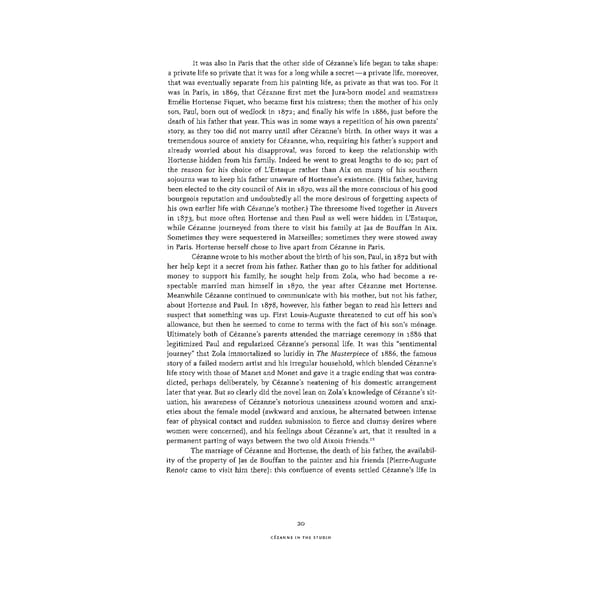It was also in Paris that the other side of Cezanne's life began to take shape: a private life so private that it was for a long while a secret—a private life, moreover, that was eventually separate from his painting life, as private as that was too. For it was in Paris, in 1869, that Cezanne first met the Jura-born model and seamstress Emelie Hortense Piquet, who became first his mistress; then the mother of his only son, Paul, born out of wedlock in 1872; and finally his wife in 1886, just before the death of his father that year. This was in some ways a repetition of his own parents' story, as they too did not marry until after Cezanne's birth. In other ways it was a tremendous source of anxiety for Cezanne, who, requiring his father's support and already worried about his disapproval, was forced to keep the relationship with Hortense hidden from his family. Indeed he went to great lengths to do so; part of the reason for his choice of L'Estaque rather than Aix on many of his southern sojourns was to keep his father unaware of Hortense's existence. (His father, having been elected to the city council of Aix in 1870, was all the more conscious of his good bourgeois reputation and undoubtedly all the more desirous of forgetting aspects of his own earlier life with Cezanne's mother.) The threesome lived together in Auvers in 1873, but more often Hortense and then Paul as well were hidden in L'Estaque, while Cezanne journeyed from there to visit his family at Jas de Bouffan in Aix. Sometimes they were sequestered in Marseilles; sometimes they were stowed away in Paris. Hortense herself chose to live apart from Cezanne in Paris. Cezanne wrote to his mother about the birth of his son, Paul, in 1872 but with her help kept it a secret from his father. Rather than go to his father for additional money to support his family, he sought help from Zola, who had become a re- spectable married man himself in 1870, the year after Cezanne met Hortense. Meanwhile Cezanne continued to communicate with his mother, but not his father, about Hortense and Paul. In 1878, however, his father began to read his letters and suspect that something was up. First Louis-Auguste threatened to cut off his son's allowance, but then he seemed to come to terms with the fact of his son's menage. Ultimately both of Cezanne's parents attended the marriage ceremony in 1886 that legitimized Paul and regularized Cezanne's personal life. It was this "sentimental journey" that Zola immortalized so luridly in The Masterpiece of 1886, the famous story of a failed modern artist and his irregular household, which blended Cezanne's life story with those of Manet and Monet and gave it a tragic ending that was contra- dicted, perhaps deliberately, by Cezanne's neatening of his domestic arrangement later that year. But so clearly did the novel lean on Zola's knowledge of Cezanne's sit- uation, his awareness of Cezanne's notorious uneasiness around women and anxi- eties about the female model (awkward and anxious, he alternated between intense fear of physical contact and sudden submission to fierce and clumsy desires where women were concerned), and his feelings about Cezanne's art, that it resulted in a permanent parting of ways between the two old Aixois friends.15 The marriage of Cezanne and Hortense, the death of his father, the availabil- ity of the property of Jas de Bouffan to the painter and his friends (Pierre-Auguste Renoir came to visit him there): this confluence of events settled Cezanne's life in 20 CEZANNE IN THE STUDIO
 Cézanne in the Studio: Still Life in Watercolors Page 34 Page 36
Cézanne in the Studio: Still Life in Watercolors Page 34 Page 36